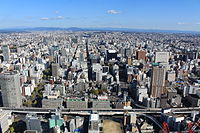Chūbu region
In a wide, classical definition, it encompasses nine prefectures (ken): Aichi, Fukui, Gifu, Ishikawa, Nagano, Niigata, Shizuoka, Toyama, and Yamanashi.In the MLIT of the central government, the jurisdiction of the Chūbu regional development bureau (中部地方整備局, Chūbu-chihō seibi-kyoku; (ja)) extends to five prefectures: Gifu, Shizuoka, Aichi, Mie and the Southern part of Nagano.The Chūbu region covers a large and geographically diverse area of Honshū which leads to it generally being divided into three distinct subregions: Tōkai, Kōshin'etsu, and Hokuriku.The Tōkai region, mostly bordering the Pacific Ocean, is a narrow corridor interrupted in places by mountains that descend into the sea.One of old Japan's most important ancient roadways, the Tōkaidō, ran through it connecting Tokyo (at that time called Edo) and Kyoto, the old imperial capital.A mild climate, favorable location relatively close to the great metropolitan complexes, and availability of fast transportation have made this area a center for truck-gardening and out-of-season vegetables.Hokuriku includes the four prefectures of Ishikawa, Fukui, most of Niigata and Toyama,[6] The district has very heavy snowfall (sometimes enough to block major roads) and strong winds in winter, and its turbulent rivers are the source of abundant hydroelectric power.


Chubu Centrair International AirportRegion of JapanCountryTime zoneMount FujiHistoric Villages of Shirakawa-gō and GokayamaHonshūJapan'sIshikawaNaganoNiigataShizuokaToyamaYamanashiKantō regionKansai regionNagoyaPacific OceanSea of Japanmountain resortsJapanese AlpsPacificNational Police AgencyJapanese archipelagoTohokuKansaiMeiji eraTōkai regionNōbi PlainChūkyōTokugawa periodTōkaidōshinkansenIse Bayheavy industryChūkyō Metropolitan AreaNagoya CityHamamatsu CityShizuoka CityGifu CityYokkaichi CityKinki regionTsu CityKōshin'etsu regionWorld War IIGifu PrefectureChūō-kōchiTōsanNiigata CityNagano CityKōfu CityHokuriku regionhydroelectric powerNiigata PrefectureKanazawa CityToyama CityFukui CityToyohashiHamamatsuKasugaiNagaokaKanazawaToyotaMatsumotoNumazuOkazakiJōetsuIchinomiyadesignated cityAichi PrefectureShizuoka PrefectureFukui Prefecturecore cityIshikawa PrefectureKofu CityYamanashi PrefectureNagano PrefectureToyama PrefectureFuji CityIchinomiya Cityspecial cityJōetsu CityKasugai CityMatsumoto CityNagaoka CityNumazu CityOkazaki CityToyohashi CityToyota CityGeography of JapanHokuriku dialectList of regions of JapanTōkai–Tōsan dialectGoogle BooksHarvard University Presspublic domainFederal Research DivisionRegionsprefectures of JapanHokkaidōTōhokuKantōNanpō IslandsHokurikuKōshin'etsuShin'etsuTōkaiChūgokuSan'inSan'yōShikokuKyūshūNorthernSouthernOkinawaPrefecturesHokkaidoAomoriFukushimaMiyagiYamagataIbarakiKanagawaSaitamaTochigiHyōgo
